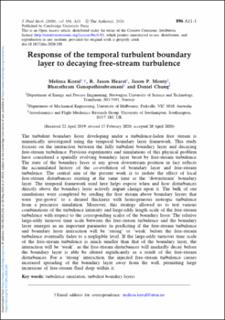| dc.contributor.author | Kozul, Melissa | |
| dc.contributor.author | Hearst, R. Jason | |
| dc.contributor.author | Monty, Jason P | |
| dc.contributor.author | Ganapathisubramani, Bharathram | |
| dc.contributor.author | Chung, Daniel | |
| dc.date.accessioned | 2020-06-03T07:53:26Z | |
| dc.date.available | 2020-06-03T07:53:26Z | |
| dc.date.created | 2020-05-28T23:57:43Z | |
| dc.date.issued | 2020 | |
| dc.identifier.citation | Journal of Fluid Mechanics. 2020, 896 . | en_US |
| dc.identifier.issn | 0022-1120 | |
| dc.identifier.uri | https://hdl.handle.net/11250/2656275 | |
| dc.description.abstract | The turbulent boundary layer developing under a turbulence-laden free stream isnumerically investigated using the temporal boundary layer framework. This studyfocuses on the interaction between the fully turbulent boundary layer and decayingfree-stream turbulence. Previous experiments and simulations of this physical problemhave considered a spatially evolving boundary layer beset by free-stream turbulence.The state of the boundary layer at any given downstream position in fact reflectsthe accumulated history of the co-evolution of boundary layer and free-streamturbulence. The central aim of the present work is to isolate the effect of localfree-stream disturbances existing at the same time as the ‘downstream’ boundarylayer. The temporal framework used here helps expose when and how disturbancesdirectly above the boundary layer actively impart change upon it. The bulk of oursimulations were completed by seeding the free stream above boundary layers thatwere ‘pre-grown’ to a desired thickness with homogeneous isotropic turbulencefrom a precursor simulation. Moreover, this strategy allowed us to test variouscombinations of the turbulence intensity and large-eddy length scale of the free-streamturbulence with respect to the corresponding scales of the boundary layer. The relativelarge-eddy turnover time scale between the free-stream turbulence and the boundarylayer emerges as an important parameter in predicting if the free-stream turbulenceand boundary layer interaction will be ‘strong’ or ‘weak’ before the free-streamturbulence eventually fades to a negligible level. If the large-eddy turnover time scaleof the free-stream turbulence is much smaller than that of the boundary layer, theinteraction will be ‘weak’, as the free-stream disturbances will markedly decay beforethe boundary layer is able be altered significantly as a result of the free-streamdisturbances. For a ‘strong’ interaction, the injected free-stream turbulence causesincreased spreading of the boundary layer away from the wall, permitting largeincursions of free-stream fluid deep within it. | en_US |
| dc.language.iso | eng | en_US |
| dc.publisher | Cambridge University Press | en_US |
| dc.rights | Navngivelse 4.0 Internasjonal | * |
| dc.rights.uri | http://creativecommons.org/licenses/by/4.0/deed.no | * |
| dc.title | Response of the temporal turbulent boundary layer to decaying free-stream turbulence | en_US |
| dc.type | Peer reviewed | en_US |
| dc.type | Journal article | en_US |
| dc.description.version | publishedVersion | en_US |
| dc.source.pagenumber | 32 | en_US |
| dc.source.volume | 896 | en_US |
| dc.source.journal | Journal of Fluid Mechanics | en_US |
| dc.identifier.doi | https://doi.org/10.1017/jfm.2020.320 | |
| dc.identifier.cristin | 1813121 | |
| dc.description.localcode | ©The Author(s), 2020.Published by Cambridge University PressThis is an Open Access article, distributed under the terms of the Creative Commons Attributionlicence (http://creativecommons.org/licenses/by/4.0/), which permits unrestricted re-use, distribution, andreproduction in any medium, provided the original work is properly cited.doi:10.1017/jfm.2020.320 | en_US |
| cristin.ispublished | true | |
| cristin.fulltext | original | |
| cristin.qualitycode | 2 | |

